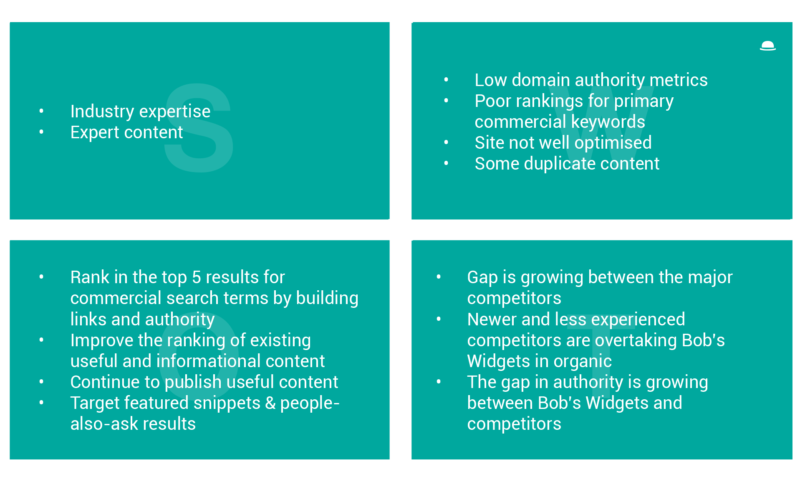
When it comes to SEO, it can be hard to know where to start — and it is easy to waste a lot of time and effort on activities that are going to deliver little in the way of returns. This is not a new problem, and it is as true with traditional marketing tactics as it is with modern digital tactics.
Fortunately, there are business and marketing methodologies that exist to simplify marketing planning. And one of our favorites at Bowler Hat is the SWOT Analysis. In this post, I am going to detail how you can use the time-proven SWOT Analysis to focus your efforts and improve your SEO.
SWOT: Strengths, Weaknesses, Opportunities and Threats
A SWOT analysis covers four key areas: Strengths, Weaknesses, Opportunities and Threats. This is a true back-to-basics approach you can use to understand where you currently are in regard to optimizing your website and improving your SEO.
This is achieved through a simple grid system that has four panels, two rows and two columns.

Figure 1.0 – SWOT chart
The top row outlines strengths and weaknesses, which are usually internal to the business. The bottom row has the opportunities and threats, which are typically from external sources.
The first column, with strengths and opportunities, details factors that should be helpful in achieving your objective. The second column has the weaknesses and threats which are harmful to achieving your objective.
In an ideal world, your SEO SWOT will build on your digital marketing strategy so you will have all your strategic ducks in a row, and SOSTAC is your friend here.
SEO SWOT Analysis
To use a SWOT analysis for SEO, we have to look at a business’s strengths, weaknesses, opportunities and threats from an SEO perspective. To help you put this into play, let us consider the following fictional business: Bob’s Widgets.
Bob’s Widgets
Bob’s Widgets has a WordPress website and is a true widget industry expert. Bob’s Widgets can serve users from their local store in Birmingham, UK, but the big win is targeting people looking to buy widgets online.
Bob does not show up in the local results when users search with a local intent. And while Bob is publishing some useful, informative content on a weekly basis, this content does not rank on the first page and receives very little traffic from search engines. Some competitor content does rank on the first page, but it is simply not in the same class as the content published by Bob and his team.
Bob’s Widgets currently has some SEO software that is reporting some technical issues, but currently, there is no plan in place to improve organic search results. The site is also not well-optimized beyond the home page and major service pages. There is currently no SEO plugin in place for the WordPress CMS, and the SEO software is reporting some duplicate content.
Bob has identified the important commercial keywords and currently ranks around the bottom of page 2 for these terms. Bob’s two main competitors rank around the top 5, with competition from Wikipedia, Amazon and eBay filling out the remaining spaces.
There is some search content around the problems that Bob’s Widgets solve, and often these searches show SERP features like featured snippets and “people also ask” results.
Bob’s Widgets has been going for nearly 15 years, yet far newer companies are starting to show up on the front page of results. Comparing these businesses, we see that although newer, they have more authority metrics than Bob’s Widgets. It appears they are actively engaged in improving their SEO.
The website does generate some inquiries, but Bob has no idea what sources of traffic are working currently.
Strengths
- Industry expertise.
- Expert content.
Weaknesses
- Low domain authority metrics.
- Poor rankings for primary commercial keywords.
- Site not well-optimized.
- Some duplicate content.
- No SEO plugin or technical optimization.
- No local results for local queries for Bob’s Widgets.
- Very basic analytics setup with no conversion tracking.
Opportunities
- Rank in the top five results for commercial search terms by building links and authority.
- Improve the ranking of existing useful and informational content.
- Continue to publish useful content.
- Target featured snippets and “people also ask” results.
- Build links to useful content pieces to build authority.
Threats
- The gap between the major competitors is growing.
- Newer and less experienced competitors are overtaking Bob’s Widgets in organic.
- The gap in authority between Bob’s Widgets and competitors is growing.
This would all be detailed in your SWOT chart as follows:

Figure 2.0 – SWOT chart for SEO opportunities
With this knowledge in place, we can now work on putting a plan together.
SEO action plan
This simple analysis helps provide an action plan of what our focus areas are and helps define the key elements of the SEO strategy for Bob’s Widgets going forward.
In the example above, Bob is publishing content and has an OK site. We just need to get the basic optimization dialed in:
- Install an SEO plugin.
- Take care of the on-page optimization.
- Resolve technical SEO issues reported by the SEO tool.
- Conduct a local SEO campaign.
- Devise a link-building strategy to build authority.
- Revise content to target featured snippets.
- Continue to publish content and invest in the SEO and content marketing strategy.
When we are looking at SEO action plans at Bowler Hat, we tend to put these into a spreadsheet with a few other figures to allow us to prioritize our work. Typically, we want to consider difficulty, time and benefit to order the tasks. Clearly, some of these jobs above will not set the world on fire but should be resolved to create a solid platform. It makes sense to get these out of the way first and then focus on the long-term tasks.
SEO SWOT questions
The following questions will help you put this into action for your business — if you can’t answer some of these questions, then this also highlights more weaknesses.
SEO Strengths
Strengths are an internal factor and are typically the easiest thing to detail, so we start here.
- What keywords do you rank well for currently?
- What content ranks well currently?
- What are your digital assets?
- What is your very best asset?
- What makes you better than your competitors?
- What drives the most organic traffic?
- What are your best links?
- What previous SEO had the best results?
SEO Weaknesses
Weaknesses are again internal, and determining weaknesses is not so easy. You will have to be honest. Smart competitors will target your weaknesses, so you must identify them as opportunities for improving your SEO.
- Which areas need improvement?
- What do your competitors do better than you (businesswise)?
- Where are your competitors stronger than you (SEO-wise)?
- How far are you behind the competition? In what areas?
- What content is currently driving little to no traffic?
- Which SEO tactics have previously failed to deliver?
- Do you have the requisite SEO skills in-house?
- Do you have the budget required to reach your SEO objectives?
SEO Opportunities
Your SEO opportunities are born out of the strengths and weaknesses. Strengths are areas to build upon. Weaknesses are areas to be explored.
- What content could be built that would have a significant impact?
- What aspects of the site could be optimized to improve results?
- What areas of the site that perform well could be expanded to perform even better?
- What weaknesses could be easily resolved?
- What link sources have we yet to tap into?
- Are there any changes to the search engine results we can leverage?
SEO Threats
Threats are the hardest element and need to be based on an understanding of your own weaknesses and your competitors’ strengths. This also needs a critical appraisal of how search engine results are changing in ways that could impact your business.
- Which competitors are strong where you are weak?
- Are newer, less experienced competitors improving their SEO?
- Is the gap between you and your competitors growing?
- Are search engine results changing in a way that could impact your business? (More ads, new SERP features, etc.)
- Are any new startups aggressively gathering market share?
Maximizing your SEO results
Often, the most difficult element of an SEO campaign is knowing where to focus your efforts. By utilizing a SWOT Analysis, you can quickly and easily direct your efforts where they will have the most impact.
I would love to hear from any of you that have put a SWOT to work to focus your SEO efforts!
Opinions expressed in this article are those of the guest author and not necessarily Search Engine Land. Staff authors are listed here.

